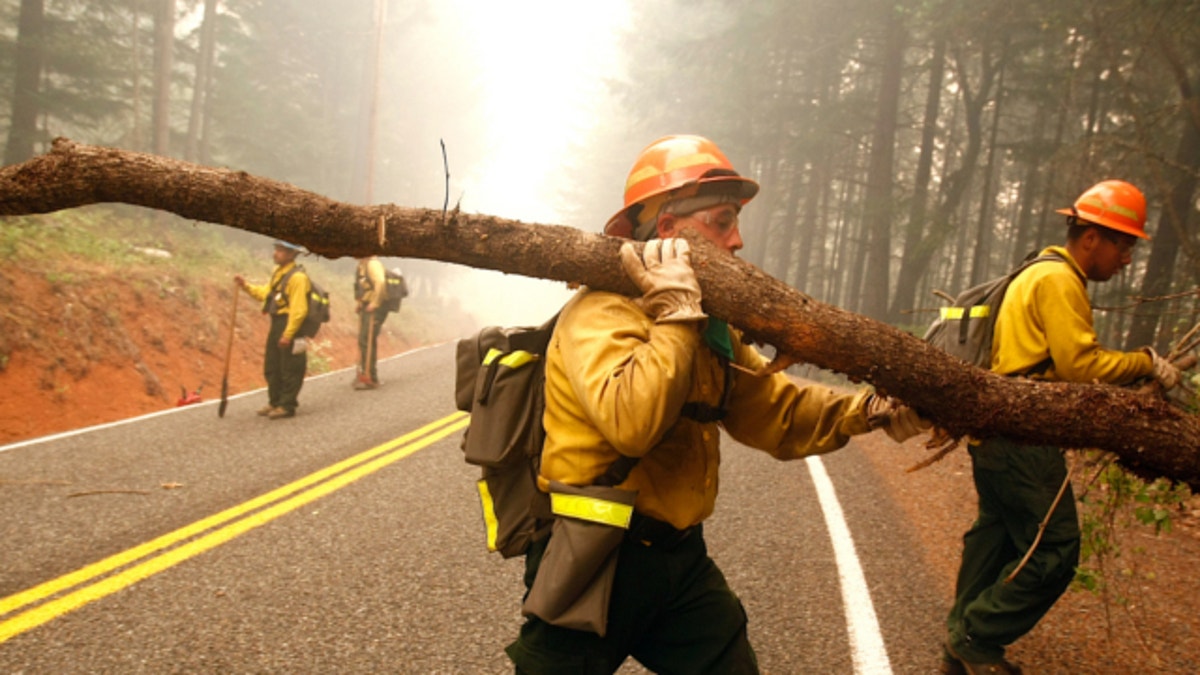
July 31, 2013: Dalles, Ore. firefighters Mario Carmona, middle, and Ismael Vega, right, help clear brush and trees near a home in Wolf Creek, Ore. (AP)
PORTLAND, Ore. – A fire crew member who died Thursday when he was hit by a falling tree in Oregon while fighting a blaze started by lightning became the 28th wilderness firefighter killed this year in the nation.
Firefighter John Hammack, 60, of Madras, Ore., was killed while removing hazardous trees in the path of a small wildfire in the remote Mt. Washington Wilderness Area in the high Cascades. It was one of multiple wildfires burning in the state.
Another firefighter, Norman Crawford, 45, of Sisters was hit on the shoulder by the tree and taken by ambulance to a hospital.
Both crew members worked for R&K Water Services of Bonney Lake, Wash. Company vice president Sandra Burleson declined comment.
The Deschutes County Sheriff's Office was investigating the incident.
Most of the wilderness firefighters who have died in the line of duty in the U.S. this year perished in an Arizona fire that killed 19.
The death of Hammack was the first in Oregon and the second blamed on snags or tree falls. A firefighter in California died from the same cause in June.
The 10-year national average is 16 deaths per year.
Hammack was among more than 4,000 firefighters battling blazes burning on more than 60 square miles in Oregon.
Earlier this week, the National Interagency Fire Center listed the Northwest as its highest priority, giving Oregon and Washington the first shot at crews and equipment as resources become available.
That's typical for this time of year because the Northwest has a later fire season — late July and August — than most of the other 10 regions. The fire season tends to start in the Southeast and shift to the Southwest before migrating north to Northern California and the Pacific Northwest.
Nationally, wildfire season has been relatively mild, with the total number of fires and the area burned running at about 60 percent of the 10-year average.
The Pacific Northwest hopes to follow the trend, but the fire center on Thursday released its fire outlook for August and it raised concerns for the region because of the dry land.
"We paint the areas that are predicted to be most active in red, and almost all of Oregon is painted red for August," said Don Smurthwaite, a fire center spokesman based in Boise. "The fire danger is real in Oregon."
The wild card is lightning.
National Weather Service meteorologist Joe Solomon in Pendleton, Ore., said 800 lightning strikes were recorded overnight, with most coming early Thursday.
He said at least that many more could be expected throughout the day as thunderstorms moved through central, north-central and far eastern Oregon. The storms were expected to bring spotty rain totaling a quarter of an inch or more.
About 40 small fires were reported along the Cascade crest and Central Oregon.
Eight wildfires considered to be major were burning in the Pacific Northwest. the largest was the Colockum Tarps Fire in Washington state. It was 25 percent contained after burning nearly 113 square miles of dry grass, sagebrush and light timber and destroying several homes and outbuildings.
Residents of about 100 scattered homes and cabins in Kittitas County were ordered to evacuate Wednesday and remained out of their homes.
In Oregon, most attention has gone to the Douglas Complex wildfires in southwest Oregon, which were started by lightning last week and have combined to scorch about 45 square miles of forestland.
No houses have burned, but nearly 500 were threatened. People in more than 100 homes have been advised to evacuate/
The Oregon National Guard is providing aircraft and manpower after Gov. John Kitzhaber declared a state of emergency in Douglas and Josephine counties.

